Abstract
The incorporation of reinforcements is a necessity to compensate for the deficiency that concrete presents with its fragile behavior and low deformation capacity. One of the solutions to improve tensile performance is the addition of fiber in random distributions throughout the volume. However, this strategy can compromise the compressive strength of concrete; consequently, the purpose of this study was to analyze the compressive strength of conventional concrete with hybrid fiber reinforcement. A behavioral equation of compressive strength as a function of the hybridization of three types of fibers (steel, polypropylene, and carbon) was determined. This equation accounted for the proportions, as well as the binary and tertiary combinations, of fibers. Results showed that the effective participation of metallic fibers and their combination with synthetic fibers contributed positively to the performance of fiber-reinforced concrete. The gain in axial compression strength reached values in the range of 10% to 19% depending on the content of total fibers and their combination, without problems in the production process.
1. Introduction
The compressive strength of concrete is one of the most important mechanical properties in the design of structures, while the tensile strength of concrete is practically dismissed due to its low value [1]. The main limitation related to the use of concrete is its fragile behavior and low deformation capacity before rupture. In the case of compression, ruptures occur due to the development of numerous independent cracks with small openings, in contrast to what occurs in traction, when a few main cracks join, reducing the total rupture surface and, consequently, energy expenditure [2].
In conventional concrete with compression strength between 25 MPa and 35 MPa, the addition of steel fibers in levels of up to 0.5% provides an increase in the compressive strength of the matrix [3]. However, fiber reinforcements, depending on the dimensions and layout in the matrix, are unable to adequately control crack location, which can compromise the durability of the material [4]. There are several positive effects associated with the addition of fibers in concrete: increase in tensile strength, improved durability of the structure, and reduction in crack openings, as well as control over and decrease in their propagation, allowing cracking to take place in a stable manner [5,6].
In fact, the incorporation of short fiber filaments into the concrete matrix to reinforce the composite material has benefits. The most notable aspect is the crack control promoted by the formation of tensile stress transfer mechanisms (tension bridges) due to the presence of fibers along the rupture planes, after the crack nucleation. Thus, the fibers prevent the propagation of cracks and contribute to the overall strength of the composite. The presence of filaments modifies the behavior of fiber-reinforced concrete, initially brittle, to a regime whose response approaches the pseudoductile. In this case, an increase in residual strength is expected (more evident for traction), along with a gain in energy dissipation capacity, in relation to the case of simple concrete, without fibers. For the cases of structural elements of reinforced concrete with steel reinforcement, the fibers favor the increase in shear strength of the interface between the matrix and the steel element [7].
Fibers can be added to the concrete mixture while still fresh, which favors their distribution at random throughout the entire volume and makes it possible to obtain a composite with more isotropic properties [8]. The ductile behavior of fiber-reinforced concrete is obtained only when the core fibers have greater elasticity than the modulus of the cementitious matrix. Metallic fibers have a high deformation modulus, where their activation occurs after the cracking of the matrix, when they start to act as bridges for transmission of loads and restriction to crack opening [9,10,11].
Synthetic fibers, on the other hand, have a deformation modulus much lower than the matrix and, thus, do not contribute to an increase in concrete ductility [12]. Given their small dimensions, synthetic fibers are likely to be more dispersed in the matrix and are more efficient in controlling micro-cracking, impeding crack coalescence, and increasing the pre-cracking strength of the material. Thus, macro fibers act primarily in the post-cracking of the matrix, while microfibers act mainly in delaying cracking [13]. The addition of different types of fibers improves the fracture properties of concrete. Hybrid reinforcement with varying percentages of steel fiber and natural fibers shows a notable increase in the flexural strength of the composite and an increase in the stiffness of the elements in reinforced concrete [14].
The hybrid use of different types of fibers in a cementitious matrix improves the strength capacity of the matrix. Fibers with smaller dimensions and lower modulus of elasticity act in the nucleation of smaller cracks. As they are short filaments, these fibers end up being no longer responsible for controlling crack opening, and larger fibers with greater modulus are expected to the assume the reinforcement of the matrix [11]. Figure 1 presents the cracking process divided into three distinct stages of reinforcement behavior with hybrid fibers. The microfibers act in the formation of cracks, causing an increase in the ductility of the cementitious matrix; thus, the macrofibers end up acting early, making the control of the crack opening greater.
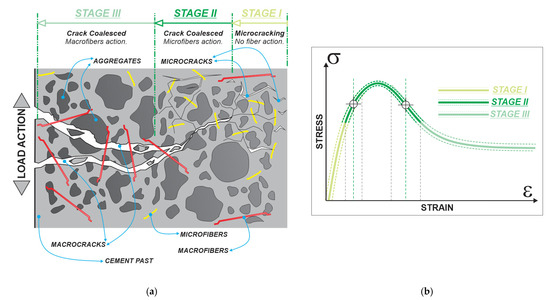
Figure 1.
(a) Crack coalescence and fiber action stages; (b) respective stress–strain diagram. Adapted from [15].
As seen in Figure 1a, in the first stage when there are only micro-cracks scattered throughout the matrix, the presence of macrofibers has no effect, and the efficiency of microfibers is quite limited. In the second stage when the micro-cracks begin to coalesce to form more well-defined cracks, microfibers start to play a fundamental role, “sewing” back the matrix and increasing the resistance to crack propagation. Finally, in the third stage, macrofibers act to increase the post-peak tension, increasing the resilience of the material [16]. If the microfibers are not mobilized before the cracks join, the efficiency of the composite drops considerably, behaving in a similar way to macrofibers but with an efficiency that may be much lower with regard to preventing the formation of cracks [15].
In addition to mechanical behavior improvements, the fire behavior of fiber-reinforced concrete can also be noticeably improved. Considering that, in most cases, concrete is reinforced with a single type of filament, it is possible to make use of hybrid fibers designed to withstand high temperatures. Another improvement is a significant decrease in the spalling of concrete with the incorporation of polypropylene fibers, as well as the curing time of concrete [17,18,19].
The hybridization of different types of fibers in concrete provides great benefits such as secondary or tertiary reinforcement, providing control of matrix cracking. The contribution of fibers to the strength and stiffness of concrete depends on the material and the mechanical and geometric properties of the fibers used [6]. Therefore, this study had a different objective, i.e., to analyze the effect of hybrid binary and tertiary mixtures of three types of fibers with different properties (steel, polypropylene, and carbon). The different composites were investigated, comparing the performance in terms of the increase in compressive strength. Results allowed the proposal of a behavior equation that represented the phenomenon and allowed a degree of calculation of mechanical properties.
It is worth mentioning that the results of the tests derived from this study can be used to propose solutions aimed at the challenges inherent to real-scale constructions and serve as a source for the calibration of numerical models and strengthening of research developed in this line, such as investigations that explain the residual flexural stiffness of steel fiber-reinforced concrete beams with steel reinforcement through tests and computer simulations using finite elements [20].
As reported in the present study, the influence of the incorporation of short steel fibers added to the concrete on the compressive strength is generally low, especially when the fiber addition is reduced or defined from moderate portions [21]. In order to reach considerably higher levels of resistance, a more in-depth and detailed study is necessary on the ideal volumetric fraction of the fiber, the stiffness of the filaments, and the dimensional compatibility between these fibers and the other particles that make up the composite. Although there is no clear evidence of the contribution of dispersed fibers to the compressive strength of the matrix, it is known that the main influence of the incorporation of fibers in the concrete mixtures occurs in the post-cracking phase, and the matrix rupture is not very fragile. From this stage, the performance of the composite is improved with regard to cracking control, ductility emergence, and energy dissipation capacity. For cases with hybrid mixtures of fibers with adequate proportions, it is possible to obtain composites with interesting performance characteristics compared to unreinforced matrices.
The compressive strength of fiber-reinforced concrete is one of the parameters adopted to verify the performance of this composite; to predict its behavior, it is common to resort to statistical models based on multivariate regression. To promote the scientific consolidation of studies in this line, it is prudent to compare the results of tests that aim to obtain additional mechanical properties in terms of compression, traction, and torsion capacity, as well as identify the relationships between them [21].
2. Materials and Methods
In order to achieve the proposed objectives, this study applied the response surface method, which in turn was based on a simplification of a second-order composite design for three-factor experiments. This method is represented graphically in Figure 2.
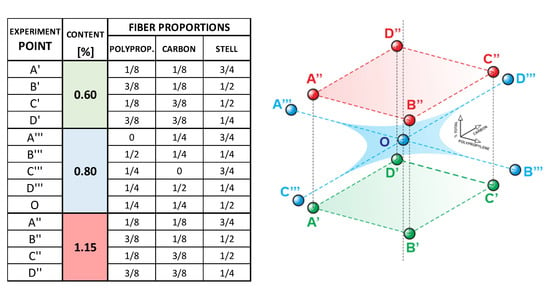
Figure 2.
Experiment points—definition of the experimental program.
In order to represent a series of tests, the composites were generated from a choice of strategic points considering the incorporation of isolated fibers, as well as binary and tertiary combinations, in order to model a more compressive strength phenomenon. For this study, a second-order composite project (SOCP) was adopted in the treatment of results to determine the influence of several factors. This procedure allowed a better evaluation of the main effects resulting from the fiber content adopted in each mixture, as well as the interactions derived from the binary and tertiary combinations of these fibers.
The application of this procedure also made it possible to define and improve the experimental matrix built from a reduced number of tests to simplify the analysis of the values obtained. Thus, there was no compromise in the reliability of the suggested range of beacon points, which were the samples established by the levels, fiber proportions, and combinations. In the horizontal plane of the cubic star matrix, the axes indicated the proportions of the secondary polypropylene and carbon fibers, whereas the vertical axis indicated the total fiber content added to the composite (which defined the quantity of metallic fibers added to each composite).
The points in the lower plane (green color) represent the total fiber content of 0.6%, and the respective P (polypropylene) + C (carbon) combinations are displayed. The mixtures in the intermediate plane (blue color) represent the cases for which the total fiber content was 0.8% and the other fractions were between P and C. In addition, the upper plane (red color) brings together the fiber combinations for a total content of 1.10%. Thus, for the combination of fibers inserted in the mixture, three distinct contents were specific. It is worth mentioning that the 13 points of experiments were strategically placed, such that four points were studied for 0.6% grades, four points were studied for 1.15% grades, and the five central points (a cubic star) were investigated. for content is 0.8%. Fiber contents were 0.60%, 0.08%, and 1.15% in relation to the volume of the materials. The evaluation of the compressive strength was performed following the recommendations of standard ASTM C39 [22]. The compression rupture stress was measured at 28 days in a sample of four specimens for each analyzed variable. The basic specimen chosen for the tests was 190 mm in height and 95 mm in diameter, keeping the height-to-diameter ratio at 2. To eliminate molding interference, and to be able to evaluate the influence of fiber-reinforced concrete poured into the structures, the specimens were extracted from a solid concrete block and compacted through mechanical vibration. The extractions were performed according to the steps shown schematically in Figure 3.
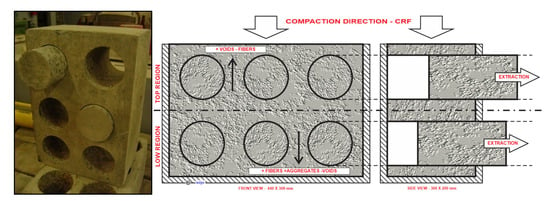
Figure 3.
Specimen extraction procedure from concrete block.
For specimen extraction, the boring equipment was operated at its minimum rotation speed. This was opted in order to avoid possible cracking and irregularities in the aspect of the specimen caused by excessive vibration of the equipment and friction between the drill and the hardened die, as well as by nonalignment errors of the machine.
For this study, concrete with a characteristic compressive strength of 25 MPa was developed. The concrete consisted of composite cement containing 5% limestone filler and natural river sand with a fineness module of 2.65 and a specific mass of 2.61 g/cm3. Basalt coarse aggregate with a fineness modulus of 6.82 and specific mass of 2.74 g/cm3 was also used. The mix ratio of concrete was 1:2.90:3.60 (cement, sand, and gravel, by mass) with a water/cement ratio equal to 0.66. The mixture showed a slump of 150 mm without the addition of fibers.
The metallic fibers were produced from drawn steel wires. A type of metallic fiber was selected, whose form factor was equal to 80, length was equal to 60 mm, and diameter was equal to 0.75 mm. Other properties and characteristics are presented in Figure 4.
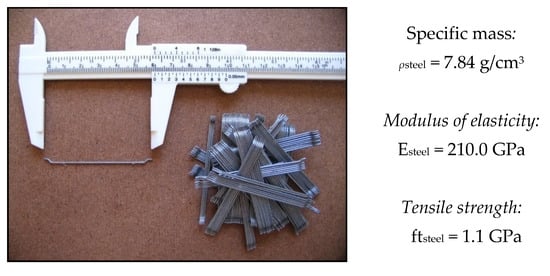
Figure 4.
Characteristics of steel fibers used in the specimens.
The polypropylene fibers used in this study were corrugated synthetic fibers already used in various other studies [23,24,25]. The fibers were synthetic monofilaments obtained through extrusion, later corrugated and cut, forming a synthetic fiber with a length of 50 mm, equivalent diameter of 100 µm, and form factor of 500. Other properties and characteristics are presented in Figure 5.
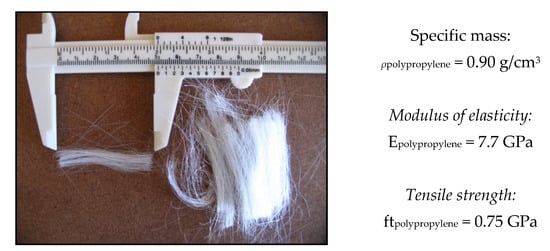
Figure 5.
Characteristics of polypropylene fibers used in the specimens.
The carbon fiber filaments used in this investigation had a single wire diameter of 0.02 μm. The adopted length was equal to the polypropylene fiber, 50 mm, as shown in Figure 6.
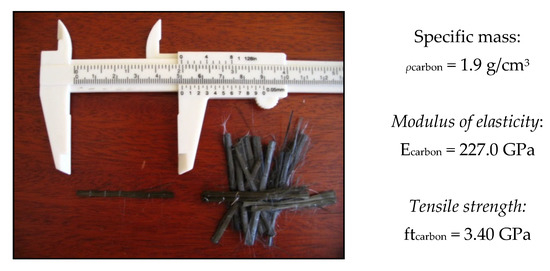
Figure 6.
Characteristics of carbon fibers used in the experimental program.
3. Results
3.1. Compressive Strength of Hybrid Fiber Mixtures
Results of the axial compressive strength test of hybrid fiber-reinforced concrete (fcHFRC) are shown in Figure 7, Figure 8 and Figure 9. In each figure, axial compressive strength results of a control test sample (0 fiber reinforcement) are shown alongside those for 0.60%, 0.80% and 1.15% total hybrid fiber replacement, respectively. In Figure 7, mixture B′ with 3/8 polypropylene, 1/8 carbon, and 1/2 steel fibers for a total percentage of 0.60% in volume of concrete was the one that presented the greatest increase in compression strength. Due to the low workability of fiber-reinforced concrete, there is great difficulty in molding the specimens. This difficulty is greater in some mixtures; this effect is potentiated by fiber hybridization. Due to this fact, the specimens may have greater variation, and this was reflected in the results, as can be seen in the variation of resistance between the specimens.
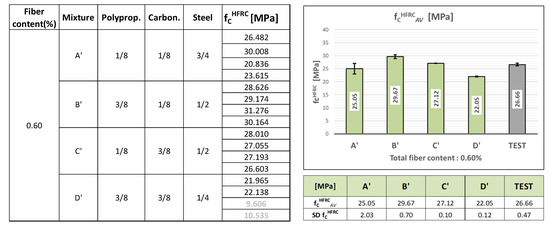
Figure 7.
Compressive strength of samples with a total fiber content of 0.60%.
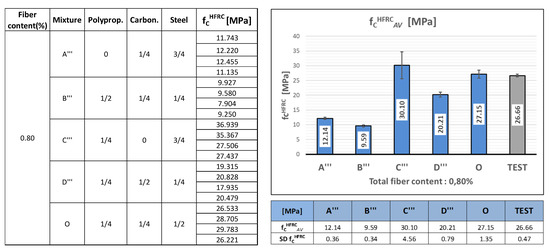
Figure 8.
Compressive strength of samples with a total fiber content of 0.80%.
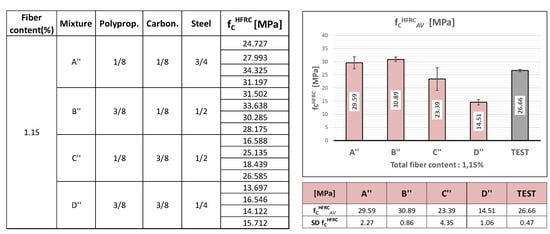
Figure 9.
Compressive strength of samples with a total fiber content of 1.15%.
The improvement of the mechanical properties of concretes with the hybridization of steel and polypropylene fibers was also reported in other studies (e.g., [26,27]). However, mixture D′ with the same total fiber content of 0.60% but with 1/4 steel, 3/8 polypropylene and 3/8 carbon fibers resulted in a lower compressive strength than the reference sample. This result was also observed for mixture A′ with combinations from 3/4 steel and fractions of 1/8 of polypropylene and carbon fibers.
These results show that the synergy in the hybrid fiber mixture caused variations in the matrix. The decrease in compressive strength was likely due to the fact that the fibers induced internal failures and caused the material to have a decrease in strength. Dawood and Ramli [28] also observed this effect in hybrid mixtures of fibers where the replacement of steel fibers by polypropylene fibers in large percentages resulted in a decrease in strength.
As for the samples with a total percentage of hybrid fibers of 0.80% in the volume of concrete, Figure 8 shows that the compressive strength of the specimens showed greater variations than Figure 7. The compressive strengths for the 0.80% hybrid fiber replacement mixture did not show a definite trend. The variation in resistance was likely not only associated with fiber content but also related to the type of hybridized fiber [11,28,29]. As can be seen in Figure 8, mixture C‴ with 1/4 polypropylene and 3/4 steel without the incorporation of carbon fibers showed a significant increase in strength. Since no definite trend was observed for this case, a step back would be recommended prior to the hybridization of these three fibers and a concrete mix of 25 MPa strength class should be first assessed to determine any negative influence of each fiber.
For samples with a total percentage of 1.15% of fibers, Figure 9 shows the trend in compressive strength. It can be seen that the strength decreased as steel fiber content decreased. This fact was associated with the influence of polypropylene and carbon fiber on the porosity of the composite.
Mixture B″ with 1/2 steel, 3/8 polypropylene, and 1/8 carbon fibers was the mixture that showed the greatest compression strength. It was possible to evaluate, on the basis of the results, that contents below 1.15% of total hybrid fibers in a mixture did not show a clear trend in compression behavior.
3.2. Statistical Modeling of Compressive Strengths of Hybrid Fiber Mixtures
Multiple regression was used because it aims to analyze the relationship between a single dependent variable (fcHFRC) and several independent variables (fibers: steel, carbon, and polypropylene). The independent variables were used with known values (proportions of different fibers) to predict the values of the selected dependent variable (compressive strength of the resulting composite). Each independent variable was weighted by the regression analysis procedure to ensure the best prediction from the set of independent variables presented. It is important to note that the coefficients calculated for the compressive strength model indicate the relative contribution of each of the independent variables (fraction of steel—S, carbon—C, and polypropylene—P) to the overall value of compressive strength. The analysis was facilitated by the regression considered and contributed to the interpretation of the influence of each variable (S, C, and P) in the definition of compressive strength; the process was interpretive. This modeling was performed considering that the values of S, P, and C were adjusted to each other through a linear combination. Thus, it was possible to obtain the best equation to represent the compressive strength. Furthermore, the modeling reproduced the effect of binary and tertiary combinations between the fibers. On the basis of the compressive strength results, a multiple linear regression model was applied to describe the influence of each type of fiber and its respective percentages. This behavior model is shown in Equation (1).
where fc is the compressive strength of hybrid fiber-reinforced concrete (fcHFRC) in MPa, and S, C, and P are the portions of steel, carbon, and polypropylene fibers added to the mixture, respectively, as a percentage of the volume.
There was a statistically significant relationship between the variables at a 99% confidence level, and the adjusted correlation coefficient (R2) was 91.08%. In addition, the standard error of the estimate yielded a standard deviation of 0.132102 of the residuals and an absolute mean error of 0.10199. Residual autocorrelation was evaluated and, in the process of processing the data and obtaining a model capable of representing the behavior of the HFRC about axial compression, no serious autocorrelation was found in the residues.
Figure 10 presents curves constructed from the behavior model equation. In the figure, the axial compressive strength is shown as a function of the percentage volume of fibers used to reinforce the composites evaluated in this study. In the figure, the fcHFRC value is expressed as a function of a single fiber acting as a reinforcement element (isolated fiber).
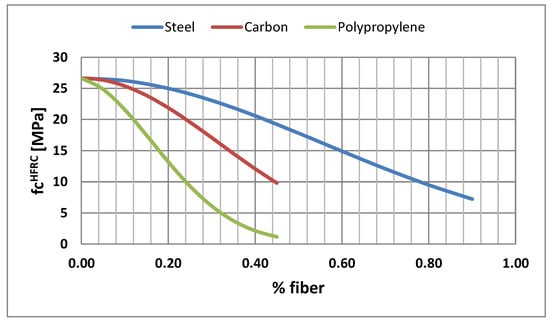
Figure 10.
Compressive strength of samples with respect to isolated fibers.
In Figure 10, it is possible to notice the greater negative influence of synthetic polypropylene fibers, impairing the compressive strength of the composite. In particular, concrete reinforced with high portions of polypropylene showed lower overall performance, especially in the absence of metallic fibers. It is known that the use of synthetic fiber helps control plastic shrinkage and prevents the appearance of large discrete cracks during the hardening phase in parts with large surfaces such as slabs. However, under compression, the authors of [24,30] found that the presence of polypropylene in large quantities promoted a significant reduction in the strength of the composite.
An important factor to be considered was the limited adhesion that this type of fiber has to the matrix, as noted in [31]. In addition, there was a difficulty with regard to the homogenization of high concentrations of polypropylene fibers, due to their similarly to carbon fibers. Carbon fibers themselves had similar but less negative effects when compared to the isolated presence of polypropylene fibers, as measured fcHFRC values for the composites reinforced with them had higher levels.
As expected, metallic fibers also played an important role in strengthening the matrix. The high concentration of this type of fiber impaired the compression strength of the composite. However, this decrease in strength, even when a large amount of metallic fibers were used, was not so expressive.
From Equation (1), it was also possible to compare the hybridization of two isolated fibers. Results are shown in Figure 11 as the behavior of the compressive strength of HFRC from hybridization of metallic fibers and carbon fibers.
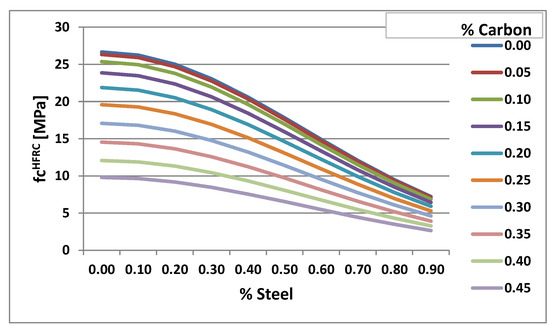
Figure 11.
Compressive strength of HFRC with steel and carbon fibers.
As seen in Figure 11, a higher content of carbon fibers inserted in the mixture resulted in a lower compression strength of the concrete. This property exhibited a nonlinear behavior with respect to the carbon fiber content; for up to 0.05% of carbon fiber incorporation, the compressive strength was mostly unaffected, whereas, as the content of inserted carbon fibers increased, the compressive strength decreased proportionally. It is also possible to notice that a greater amount of steel fibers in the mixture resulted in a lower influence of carbon fiber content on compressive strength.
Figure 12 shows the results related to the binary combination of metallic fibers and polypropylene fibers. As seen in the figure, there was a hybridization trend of greater compressive strength with increased incorporation of polypropylene fibers. Maximum compressive strength gains occurred with the use of 0.30% to 0.45% polypropylene fibers for any percentage of metallic fibers. In the case of lower proportions of polypropylene fibers inserted in the concrete, even with high levels of steel fibers, the compressive strength tended to decrease. According to a study by Qin et al. [32], the incorporation of polypropylene fibers provided an increase of up to 6.14% in strength. Moreover, it was also reported that, if the fiber did not impair the workability, the compressive strength was also not impaired.
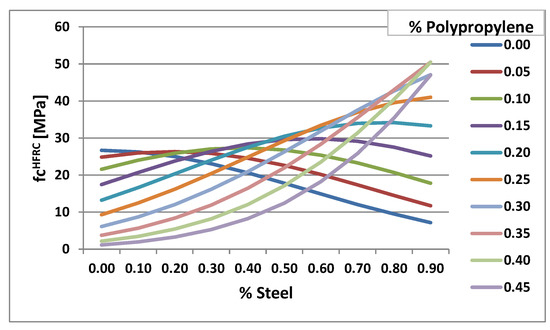
Figure 12.
Compressive strength of HFRC with steel and polypropylene fibers.
Results for the matrix incorporating polypropylene and carbon fibers are shown in Figure 13. From the figure, it is evident that these fibers did not provide a reinforcement of compression strength. It should be noted that both fibers had reduced shape factors and, in addition to acting in a matrix microregion, had dimensions incompatible with the coarse aggregates used in the concrete. In fact, this is likely due to the fact that these fibers did not present ideal adherence with the other constituents that this combination proved to be ineffective.
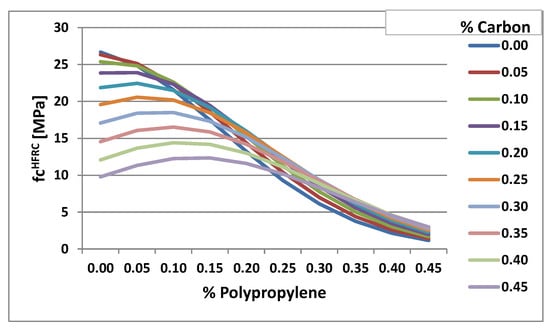
Figure 13.
Compressive strength of HFRC with polypropylene and carbon fibers.
Figure 13 shows that adding larger quantities of polypropylene and carbon fibers further increased the negative effects, strongly reducing the compression strength of the matrix. Other studies (e.g., [33,34,35]) presented the same behavior for other types of matrices. The accumulation of these microfibers caused the occurrence of problems related to the loss of homogeneity and, consequently, weakening of the material due to the loss of adhesion at the fiber–matrix interface, culminating in the loss of post-cracking behavior.
From the behavior model equation determined in this study, which described the compressive strength of the composite with respect to fiber content and combinations, a comparison of the values obtained by the equation with the results found in the tests was performed. Results are shown in Figure 14. As seen in the figure, there was a low dispersion of responses between the compression strength of the proposed model and the mixtures for most fiber combinations adopted in the matrix reinforcement, whether they were isolated or combined in binary or tertiary form.
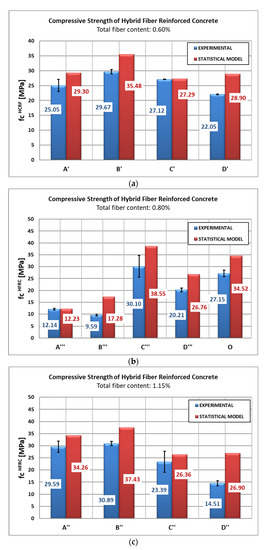
Figure 14.
Comparison of compressive strength between the determined behavior equation and the tests performed—total fiber content: (a) 0.60%; (b) 0.80%; (c) 1.15%.
With a total fiber addition of 0.60%, Figure 14a shows that all combinations had compressive strengths very close to the strength of concrete without fibers. Mixture B′, in particular, had a strength slightly higher than the average of 26.67 MPa both for the experimental value and for the result from the behavior model. It should be noted that the proportion of steel fiber adopted for mixture B′ was 1/2 in relation to the total fiber content and 3/8 for polypropylene fiber. The corresponding compressive strengths for mixture C′ obtained experimentally and the values derived from the behavior model were also significantly similar. The fact that they were equivalent to the matrix strength indicated that the characteristic combination of this mixture of 1/2 steel and 1/8 polypropylene fibers did not compromise the original performance of the composite.
Figure 14b shows the results with regard to mixtures in which the total fiber content added was 0.80%. As seen in the figure, mixtures C‴ and O had the highest values of axial compressive strength. These mixtures had, in their compositions, 1/4 polypropylene and fractions of 3/4 and 1/2 metallic fibers, respectively, for mixture C‴ and O. However, although mixture A‴ had 3/4 metallic fiber content similar to mixture C‴, the compressive strength values of A‴ were much lower compared to the behavior presented for simple concrete. One of the reasons for this result might be the absence of polypropylene in the combination. Composite mixtures B‴ and D‴, whose strengths were also lower than the reference, were made with a proportion of steel fibers equivalent to 1/4 of the total content of 0.80%.
Figure 14c shows the results corresponding to mixtures with 1.15% of total fiber content. Overall, the high content of metallic fiber and its combination with polypropylene resulted in increased strength of the composite materials. Furthermore, there was a similarity between the compressive strength of mixtures A″ and B″, despite mixture A″ being defined with 3/4 metallic and 1/8 polymeric fibers, while mixture B″ had 1/2 metallic and 3/8 polypropylene fibers. Once again, even though the mixtures of this group had a high total fiber content of 1.15%, it could be inferred that metallic fiber, when inserted in low levels combined with carbon and polypropylene fibers, did not contribute to the reinforcement of the matrix and, as a consequence, did not increase the compressive strength of the composite.
The combinations of fibers that had the tendency to contribute to the reinforcement of the matrix and presented the best performance in terms of axial compressive strength can be summarized as follows:
In the case of a total fiber content of 0.60% with respect to concrete volume, a 10% increase in strength with respect to reference concrete was observed when the percentage of metallic fibers corresponded to half of the hybrid combination and the percentage of polypropylene fibers was threefold greater than that of carbon fibers;
In the case of a total fiber content of 0.80% with respect to concrete volume, a gain of slightly higher than 19% in strength was possible with a binary hybrid combination of 1/4 polypropylene and 3/4 steel fibers;
In the case of a total fiber content of 1.15% with respect to concrete volume, an average gain of 15% in strength was possible with fractions identical to those of 0.60% (1/2 steel, 3/4 polypropylene, and 1/4 carbon fibers).
4. Conclusions
This study presented an experimental investigation of a concrete with low compressive strength reinforced with hybrid mixtures of three types of fibers. The following conclusions were drawn from the results:
There were no significant gains in compressive strength with the insertion of fibers, whether in simple or hybrid mixtures. However, hybrid mixtures of fibers with adequate proportions resulted in composites with interesting performance characteristics in comparison to the original matrices.
Fiber hybridization altered the compressive strength of low-strength concrete. The combination of steel and polypropylene fibers proved to be the most effective, but the compressive strength of concrete was not significantly improved. According to the data, the best fcHRFC results were obtained with combinations containing proportions in the order of 50% to 75% of metallic fibers complemented with 25% to 37.5% of polypropylene fiber.
A behavior model equation was elaborated to represent the compressive strength of hybrid fiber mixtures. The expression was found to be adequate in representing the behavior of the compressive strength of binary and ternary fiber mixtures in the matrix. Thus, the expression can be used to estimate values of mechanical properties related to the adjustments of constitutive laws or can be applied in numerical simulations within the limits of its formulation.
The results obtained and analyzed in this study pointed generally to the potential use of concrete reinforced with hybrid fibers in structures. However, some precautions throughout production must be taken, whether in the ideal choice of fibers and their proportions or in the mixing process.
The properties generated by the distribution of fibers within the matrix are considered very important for an optimal understanding of the mechanical behavior of fiber-reinforced composites, but they were not evaluated in this investigation. Nondestructive testing procedures (e.g., X-ray tests, electron microscopy, and ultrasound testing) are known to produce excellent results for this type of investigation. The study considered the random distribution of filaments to reinforce the composite material, without adopting any intervention to control this aspect. Although there is knowledge about the relevance of a complementary analysis that considers the behavior of the interface zone between the reinforcing filaments and the concrete matrix, investigations of the fiber–matrix anchoring mechanisms and the effect of air entrained by the presence of additives, among others, were not included in this study.
Author Contributions
U.C.d.M.Q., development of the experimental tests and compilation of results; R.C., analysis of results, discussion, and comparisons with the literature; B.F.T. and L.C.P.d.S., review of results and valuable contributions to their interpretation. All authors have read and agreed to the published version of the manuscript.
Funding
This research received no external funding.
Informed Consent Statement
Not applicable.
Data Availability Statement
The data in this study are available on request from the corresponding author.
Acknowledgments
The authors acknowledge the financial support provided by Coordenação de Aperfeiçoamento de Pessoal de Nível Superior (CAPES) and Coordenação de Aperfeiçoamento de Pessoal de Nível Superior (CNPq). Additional support was provided by the Laboratório de Ensaios e Modelos Estruturais (LEME) of the Federal University of Rio Grande do Sul (UFRGS).
Conflicts of Interest
The authors declare no conflict of interest.
References
- Nataraja, M.C.; Sanjay, M.C. Modified Bolomey equation for the design of concrete. J. Civ. Eng. IEB 2013, 41, 59–69. [Google Scholar]
- Mehta, P.K.; Monteriro, P.J. Concreto: Microestrutura, Propriedades e Materiais, 2nd ed.; IBRACON: São Paulo, Brasil, 2014. [Google Scholar]
- Lee, J.H.; Cho, B.; Choi, E. Flexural capacity of fiber reinforced concrete with a consideration of concrete strength and fiber content. Constr. Build. Mater. 2017, 138, 222–231. [Google Scholar] [CrossRef]
- Quinino, U.C.M. Investigação Experimental das Propriedades Mecânicas de Compósitos de Concreto com Adições Híbridas de Fibras. Doctoral Thesis, Universidade Federal do Rio Grande do Sul—UFRGS, Rio Grande, Brasil, 2015. [Google Scholar]
- Lerch, J.O.; Bester, H.L.; van Rooyen, A.S.; Combrinck, R.; de Villiers, W.I.; Boshoff, W.P. The effect of mixing on the performance of macro synthetic fibre reinforced concrete. Cem. Concr. Res. 2018, 103, 130–139. [Google Scholar] [CrossRef]
- Da Silva, G.C.S.; Christ, R.; Pacheco, F.; de Souza, C.F.N.; Gil, A.M.; Tutikian, B.F. Evaluating steel fiber-reinforced self-consolidating concrete performance. Struct. Concr. 2019, 21, 448–457. [Google Scholar] [CrossRef]
- Guler, S.; Yavuz, D.; Korkut, F.; Ashour, A. Strength prediction models for steel, synthetic, and hybrid fiber reinforced concretes. Struct. Concr. 2019, 20, 428–445. [Google Scholar] [CrossRef] [Green Version]
- Johnston, C.D. Fiber Reinforced Cements and Concretes; Taylor & Francis: Otawwa, ON, Canada, 2010; Volume 2010. [Google Scholar]
- Pacheco, F.; Christ, R.; Quinino, U.; Tutikian, B.F. Effects of fiber hybridization in advanced cementitious composites durability in humid and aggressive environments. Rev. Mater. 2018, 23, 3. [Google Scholar] [CrossRef]
- Zollo, R.F. Fiber-reinforced concrete: An overview after 30 years of development. Cem. Concr. Compos. 1997, 19, 107–122. [Google Scholar] [CrossRef]
- Chasioti, S.G.; Vecchio, F.J. Shear behavior and crack control characteristics of hybrid steel fiber-reinforced concrete panels. ACI Struct. J. 2017, 114, 209–220. [Google Scholar] [CrossRef] [Green Version]
- Caggiano, A.; Gambarelli, S.; Martinelli, E.; Nisticò, N.; Pepe, M. Experimental characterization of the post-cracking response in Hybrid Steel/Polypropylene Fiber-Reinforced Concrete. Constr. Build. Mater. 2016, 125, 1035–1043. [Google Scholar] [CrossRef]
- Shi, X.; Park, P.; Rew, Y.; Huang, K.; Sim, C. Constitutive behaviors of steel fiber reinforced concrete under uniaxial compression and tension. Constr. Build. Mater. 2020, 233, 117316. [Google Scholar] [CrossRef]
- Dawood, E.T.; Ramli, M. Contribution of hybrid fibers on the hybrid fibers on the properties of high strength concrete having high workability. Procedia Eng. 2011, 14, 814–820. [Google Scholar] [CrossRef] [Green Version]
- Lawler, J.S.; Wilhelm, T.; Zampini, D.; Shah, S.P. Fracture processes of hybrid fiber-reinforced mortar. Mater. Struct. Constr. 2003, 36, 197–208. [Google Scholar] [CrossRef]
- Yoo, D.Y.; Banthia, N.; Yoon, Y.S. Predicting the flexural behavior of ultra-high-performance fiber-reinforced concrete. Cem. Concr. Compos. 2016, 74, 71–87. [Google Scholar] [CrossRef]
- Gil, A.; Pacheco, F.; Christ, R.; Bolina, F.; Khayat, K.H.; Tutikian, B. Comparative study of concrete panels’ fire resistance. ACI Mater. J. 2017, 114, 5. [Google Scholar] [CrossRef]
- Klippel, S.; Prager, L.G.; Silva, P.E.M.; Bolina, F.L.; Tutikian, B.F. Comparative study of fire resistance and acoustic performance of ceramic brick walls in concern to NBR 15575 in residential buildings in Brazil. Dyna 2018, 85, 53–58. [Google Scholar] [CrossRef]
- Bolina, F.; Christ, R.; Metzler, A.; Quinino, U.; Tutikian, B. Comparison of the fire resistance of two structural wall systems in light steel framing. Dyna 2017, 84, 201. [Google Scholar] [CrossRef]
- Gribniak, V.; Ng, P.-L.; Tamulenas, V.; Misiūnaitė, I.; Norkus, A.; Šapalas, A. Strengthening of Fibre Reinforced Concrete Elements: Synergy of the Fibres and External Sheet. Sustainability 2019, 11, 4456. [Google Scholar] [CrossRef] [Green Version]
- Deifalla, A.F.; Zapris, A.G.; Chalioris, C.E. Multivariable Regression Strength Model for Steel Fiber-Reinforced Concrete Beams under Torsion. Materials 2021, 14, 3889. [Google Scholar] [CrossRef]
- ASTM C39/C39M. Standard Test Method for Compressive Strength of Cylindrical Concrete Specimens. In Annual Book of ASTM Standards; ASTM: Philadephia, PA, USA, 2010; pp. 1–7. [Google Scholar]
- Karahan, O.; Atiş, C.D. The durability properties of polypropylene fiber reinforced fly ash concrete. Mater. Des. 2011, 32, 1044–1049. [Google Scholar] [CrossRef]
- Kakooei, S.; Akil, H.M.; Jamshidi, M.; Rouhi, J. The effects of polypropylene fibers on the properties of reinforced concrete structures. Constr. Build. Mater. 2012, 27, 73–77. [Google Scholar] [CrossRef]
- Serrano, R.; Cobo, A.; Prieto, M.I.; González, M.d.N. Analysis of fire resistance of concrete with polypropylene or steel fibers. Constr. Build. Mater. 2016, 122, 302–309. [Google Scholar] [CrossRef] [Green Version]
- Bhutta, A.; Borges, P.H.R.; Zanotti, C.; Farooq, M.; Banthia, N. Flexural behavior of geopolymer composites reinforced with steel and polypropylene macrofibers. Cem. Concr. Compos. 2017, 80, 31–40. [Google Scholar] [CrossRef]
- Christ, R. Desenvolvimento de Compósitos Cimentícios Avançados à Base de Pós-Reativos com Misturas Híbridas de Fibras e Reduzido Impacto Ambiental. Dissertação de Mestrado, UNISINOS, São Leopoldo, Brasil, 2014; p. 111. [Google Scholar]
- Dawood, E.T.; Ramli, M. Mechanical properties of high strength flowing concrete with hybrid fibers. Constr. Build. Mater. 2012, 28, 193–200. [Google Scholar] [CrossRef]
- Banthia, N.; Yan, C.; Saks, K. Impact Resistance of Fiber Reinforced Concrete at Subnormal Temperatures. Science 1998, 20, 393–404. [Google Scholar]
- Bindiganavile, V.; Banthia, N.; Aarup, B. Impact response of ultra-high-strength fiber-reinforced cement composite. ACI Mater. J. 2002, 99, 543–548. [Google Scholar]
- GangaRao, H.V.S.; Taly, N.; Vijay, P.V. Reinforced Concrete Design with FRP Composites; CRC Press: New York, NY, USA, 2007. [Google Scholar]
- Qin, Y.; Zhang, X.; Chai, J.; Xu, Z.; Li, S. Experimental study of compressive behavior of polypropylene-fiber-reinforced and polypropylene-fiber-fabric-reinforced concrete. Constr. Build. Mater. 2019, 194, 216–225. [Google Scholar] [CrossRef]
- Madhavi, T.C.; Reddy, M.; Kumar, P.; Raju, S.; Mathur, D. Behaviour of polypropylene fiber reinforced concrete. Int. J. Appl. Eng. Res. 2015, 10, 22627–22638. [Google Scholar]
- Song, P.S.; Hwang, S.; Sheu, B.C. Strength properties of nylon- and polypropylene-fiber-reinforced concretes. Cem. Concr. Res. 2005, 35, 1546–1550. [Google Scholar] [CrossRef]
- Enrenbring, H.Z. Comportamento de Concretos Reforçados com Fibras de Polipropileno (PP), Álcool Polivinílico (PVA) e Recicladas de Poliéster (POL) em Relação à Retração por Secagem Restrindiga e às Propriedades Mecânicas; Universidade do Vale do Rio dos Sinos: Sao Leopoldo, Brasil, 2017. [Google Scholar]
Publisher’s Note: MDPI stays neutral with regard to jurisdictional claims in published maps and institutional affiliations. |
© 2022 by the authors. Licensee MDPI, Basel, Switzerland. This article is an open access article distributed under the terms and conditions of the Creative Commons Attribution (CC BY) license (https://creativecommons.org/licenses/by/4.0/).